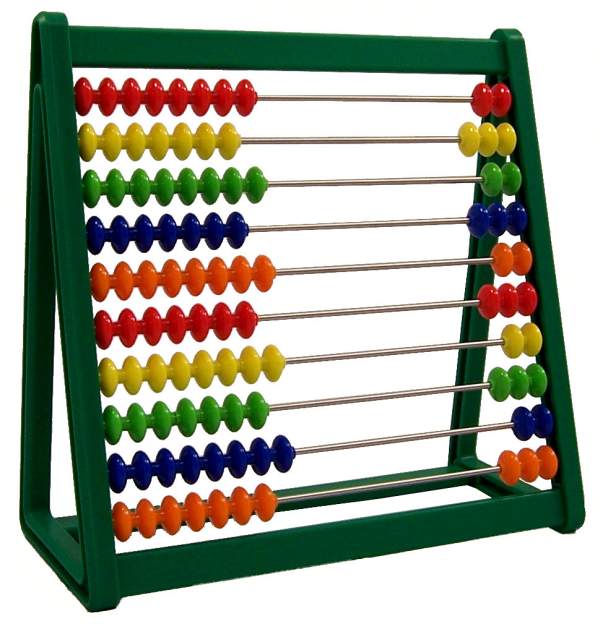

This object and other abaci from the Smithsonian Institution’s National Museum of American History are shown at the website. Final answers are usually represented by the smallest possible number of beads-five one-beads would be replaced by one five-bead.

Thus, the abacus shown in the photograph represents the number 555,615. Five can be represented by five one-beads brought up to the cross-bar or by one five-bead brought down. In the Chinese form of the instrument, two beads above the cross-bar each represent five and those below it represent one. The beads on the rods in this abacus represent numbers in base ten, reading from right to left as 1s, 10s, 100s, etc., as in European notation. In the late nineteenth and early twentieth centuries, western scientists and mathematicians sometimes exhibited abaci as examples of eastern culture, This is one such abacus, from the mathematics department of Brown University. Each wire represents the ones, tens, hundreds, and so on. The beads are arranged on wires stretched across a frame. On this instrument, calculations are made with beads, or counters, instead of numerals. The term “counter” eventually came to refer not only to an object used in calculations but also to the place in a store where transactions are carried out.īy the eighteenth century, the abacus was well established in China and Russia. Long before the invention of the electronic calculator or the computer, people counted and did calculations with a device called an abacus. In Medieval and Renaissance Europe, merchants commonly did calculating by moving wooden or metal counters along lines drawn on a wooden table known as counting board, a counter-board, or a reckoning-board. The abacus has taken many forms over the centuries.

Our modern terms “calculate” and “calculus” come from the term calculi, while the word “abacus” comes from a Greek word meaning a board or slab, or a calculating table. Small stones known as calculi, from the Greek khalix, pebble, were moved along lines drawn in stone or sand. The instrument may have originated in the Middle East before the time of Christ. The abacus is a computing device on which arithmetic calculations are performed by sliding counters (beads, pebbles, or flat discs) along rods, wires or lines. The rod on the right hand side of the unit rod would be used to represent the decimal place value digits.īefore using the abacus, it should be made sure that the value on each rods are in the neutral position representing “0”.Chinese Abacus, ca 1925, Smithsonian Institution negative number DOR 2010-0104. This rod indicate the unit place value rod and the rods towards the left of this unit rod would be tens’ rod, hundreds’ rod, thousands’ rod etc. There is a unit point (a white dot) marked at every 3rd rod on the abacus. The thumb and the forefinger of our right hand and the forefinger and middle finger of our left hand are used to move the beads. The beads are moved up and down the rods with the help of fingers. Each lower bead has a value of “1” and each upper bead has a value of “5”. The upper part has one bead known as the upper bead or the heaven bead. The lower part has 4 beads known as the lower bead or earth bead. ABACUS is a simple calculating tool used to do all the basic arithmetic calculations like addition, subtraction, multiplication and division.Ībacus consist of rods in which beads move up and down.Ī beam divides the abacus rod into two parts.


 0 kommentar(er)
0 kommentar(er)
